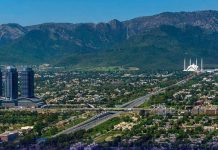1 August 2022 – 25 September 2022
Supported by ZVM Rangoonwala Foundation
The British Council and Victoria and Albert Museum (V&A) have launched What is Seen and What is Not by inter-disciplinary artist Osman Yousefzada, at the V&A in London. This series of interventions responds to the75th anniversary of Pakistan and explores themes of displacement, movement, migration, and the impact of the climate crisis. The interventions across the museum are free to visit, and have been commissioned by the British Council in partnership with the V&A and the High Commission of Pakistan as part of the British Council’s festival season ‘Pakistan/UK: New Perspectives’.
Osman’s work is a tripartite of site-specific works, and brings together textiles, wrapped objects and a seating installation to showcase the rich variety of traditional and contemporary Pakistani craftsmanship. Together, the works present Osman’s unique and highly personal perspective on migratory experience and identity and offers a subtle and contemplative space to engage with objects and craft techniques rooted in the heritages of Pakistani culture. Working collaboratively with local craftsmen, Osman developed new techniques and stitches – working on non-traditional materials, which he compliments with painting, producing a body of work reflecting on shrines and ritualised spaces of transcendence.
Osman Yousefzadasaid: “It’s a great honour to be commissioned to reflect on the 75 years of Pakistan’s independence. What is Seen and What is Not offers a portrait of contemporary Pakistan, through a British diasporic lens as it attempts to reel away from colonial subjugation. However, Pakistan is still a casualty of neo-colonial structures, contributing less than 1% to green gas emissions and in return it is the 5th most vulnerable country to climate change, as rising temperatures result in great floods and an eventual loss of the Himalayan ice reservoirs, causing tremendous displacement and a loss of homeland to its people.”
SkinderHundal MBE, Director Arts, British Councilsaid: “The British Council is proud to be working with Osman Yousefzada, the V&A and the High Commission of Pakistan on What Is Seen, What Is Not as part of our Pakistan/ UK New Perspectives Season. This project is an embodiment of what the British Council and the High Commission of Pakistan are setting out to achieve with the New Perspectives Season- creating a bridge between cultures, challenging perceptions, and opening up new narratives and channels of discourse between contemporary societies in Pakistan and the UK. As we mark the 75th anniversary of Pakistan, this work both acknowledges the important shared histories of our nations and creates space for new perspectives.”
Director of the V&A, Tristram Hunt said: “We are thrilled to curate these ambitious site-specific works by Osman Yousefzada, in partnership with the British Council and the High Commission of Pakistan, to mark the 75th anniversary of the foundation of Pakistan. What is Seen and What is Not is a commentary on the migratory experience, displacement and the effects of the climate crisis, while showcasing the ingenuity of Pakistani craftsmanship. Interventions such as this offer an opportunity to bring diaspora voices to the heart of the V&A, to be in conversation with the museum’s vast South Asia collection.”
Visitors to the V&A will first encounter Osman’s work in the Dome in the form of several large-scale textile banners depicting abstracted figures in motion. Handcrafted using different dying techniques with woven surface decoration and metallic threads, the figures are suggestive ancient talismanic symbols. The works will invite contemplation on the complex riches of both sacred and secular histories of South Asian culture and Pakistan’s identity today.
Moving through the museum and into the sculpture galleries, a wooden structure evoking makeshift shrines found around South Asia, will showcase domestic-sized wrapped objects cast in glass, clay and wrapped in richly woven textile. Appearing to contain domestic items such as a pot or vessel, the objects evoke themes of migration and reflect upon how displaced people travel with treasured possessions, making the journey from place to place, country to country, necessitated by social, political, or economic upheaval.
For the final intervention, the John Madejeski Garden will be transformed into a space for communal contemplation, with a number of colourful charpai and mora stools, designed to be used, moved and enjoyed by visitors, reflecting themes of displacement. Each charpai (a ubiquitous day bed found across South Asia) is handmade using different weaving techniques to celebrate the diversity of the textile heritage of Pakistan. Finally, at the centre of the Garden installation, visitors will encounter a wooden vessel, typically found in the mangroves of coastal Pakistan. Moored off water, the vessel symbolises the precarity of water-dependent communities and the erosion of natural environments at this moment of global climate crisis as well as colonial histories of exploitation.












